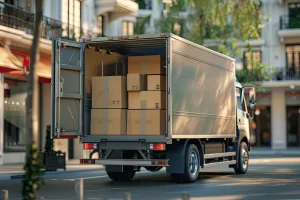Last summer, Sarah and Mike chose to live in New York City. They found an old building in the East Village that was perfect. But, it was on the fourth floor without an elevator. They realized moving everything up those stairs would be tough.
We’ve gathered nine key tips for moving into a walk-up apartment. These tips include downsizing, packing smart, and staying safe on steep stairs. They’re from people who’ve faced the same challenge. These tips will help you handle the move without an elevator.
With these tips, you can protect your stuff and reduce stress and strain. Welcome to your new home!
Master the Art of Moving into a Building with No Elevator
Moving into a walk-up building without an elevator is a challenge. Yet, with the right tools, it’s easier. Moving straps and dollies are must-haves for heavy items. They help you move things up steep and narrow stairs.
Here’s how to tackle moving upstairs:
- Plan Ahead: Check if your furniture can fit in the stairwell before moving day. Taking larger items apart can help too.
- Use Moving Straps: Moving straps use leverage to make carrying heavy things easier. They also help prevent back strain and give more control.
- Leverage Dollies and Hand Trucks: These are great for moving smaller, heavy things upstairs. Just be sure everything is secured well.
- Work in Teams: Working with a partner or team is helpful. Have someone guide from the top and another from the bottom.
- Take Breaks: Going up and down stairs is tiring. Drink water and rest often to keep going.
To succeed in moving without an elevator, mix the right tools with good techniques. Use these tips to move smoothly and safely.
Smart Packing Hacks for Moving into a Walk-Up Apartment
Moving into a walk-up apartment requires smart planning and packing. Here are some smart packing tips to make the move smoother. It’s all about being efficient and careful.
- Opt for Suitcases with Wheels: Use suitcases with wheels for heavy items. They ease the strain on your back and make stairs less of a challenge.
- Use Small, Sturdy Boxes: Smaller boxes are easier to carry and less likely to break. They help avoid overloading.
- Label Everything Clearly: Clearly label each box with its contents and destination room. It makes unpacking easier and helps find essentials quickly.
- Distribute Weight Evenly: Balance the weight in each box. This avoids making boxes too heavy and prevents injury.
- Use Soft Items as Padding: Wrap breakables in clothes, towels, or blankets. This saves space and adds protection during the move.
Using these packing hacks for moving can simplify moving into a walk-up apartment. With good preparation and smart packing, your new place will feel like home quickly.
Get the Right Help: Moving Without an Elevator
Moving into an apartment without an elevator has its challenges. You’ll need the right kind of help. It might be hard to choose between asking friends and family or hiring professionals. But it’s a vital step for a smooth move.
Thinking about asking friends and family? First, think about if they’re up to the task. They might save you some cash compared to hiring movers. Yet, without professional skills, you risk injuries or harm to your stuff.
Professional movers, however, know exactly what they’re doing with no elevator moves. If you’re searching for moving help, find movers who offer specialized services. Full packing services are a big plus if you want to ease your stress and workload.
Here’s what to consider when picking the right movers:
- Experience with no elevator moves.
- Full packing services available.
- Prices that won’t break the bank.
In the end, you want to move into your new place smoothly and easily. Think about what you need and pick the best option for your no-elevator move.
Best Times to Move into a Walk-Up Building
When you’re moving to an apartment without an elevator, choosing the right time is key. It helps avoid extra troubles. Planning when to move can make the process easier for everyone.
Picking the best times to move is crucial for an easy move:
- Early Morning Hours: Moving between 7:00 AM and 9:00 AM is smart. This avoids the busy times on stairs, helping in buildings without elevators.
- Mid-Week Moves: Tuesday and Wednesday are the best days to move. Weekends are busier, which makes moving harder.
- Off-Peak Seasons: Think about moving in fall or winter. Summer is the busiest season, so it’s harder to move then.
- Weather Conditions: Always watch the weather before your move. Mild weather is best to avoid dangers like slippery stairs.
- Building Management Policies: Talk to your building’s management about moving times. Some places only allow moving at certain times.
Planning your move for these times can make a big difference. It makes moving into an apartment without an elevator easier and safer for everyone.
How to Safeguard Your Belongings and Your Back When Moving
Moving into a walk-up building requires strength and smart planning. To keep your belongings safe and look after your well-being, follow these tips.
- Use Proper Packing Materials: Buy strong boxes, bubble wrap, and packing tape to keep your stuff safe. These sturdy materials prevent damage during the move and the climb up stairs.
- Label Your Boxes: Make sure each box is labeled with its contents and the room it goes in. This makes unpacking easier and ensures fragile items get extra care.
- Pack Smart: Put heavy items at the bottom and light items on top. This makes boxes easier to lift and lowers the chance of getting hurt.
- Use Tools and Aids: Use dollies, hand trucks, and furniture sliders to ease the load. These tools help keep your back safe and make moving big items easier.
- Adopt Proper Lifting Techniques: Bend at your knees and lift with your legs, not your back. Holding the box close also helps reduce back strain.
Using these safety tips can make moving less hard and safer. Make sure your items are well-packed and labeled. Protect your back by using the right tools and lifting correctly. These steps ensure an efficient, injury-free move.
The Importance of Clear Communication with Building Management
Before your move, talking well with building management is crucial for a smooth change. Open talks with the staff let you tackle key points like elevator use, stair access, and parking space. This way, you dodge sudden issues and set up your moving day arrangements better.
Let building management know your moving date and time first. Doing this early helps them give you rules or limits you need to follow. This ensures you stick to the building’s policies.
- Elevator Reservations: Ask if you can book the service elevator for your move. This step makes moving easier, even without an elevator.
- Stair Access: Talk about when is best to use the stairs. This is to not bother other people living there during busy times.
- Loading Zones: See if there are special spots for unloading. And if you can book them for easier access.
Creating a good relationship with your building management helps a lot with your move. It also makes future talks better. Talking on time and clearly about your move shows you respect their rules. It also makes your move go smoother.
How to Secure Prime Parking for Your Elevator-Free Move
Parking is often missed in moving plans, especially in cities. But, getting the right parking spot is key to a smooth move. Learn about your area’s street parking laws early. Cities have rules for parking big vehicles. Knowing them prevents fines and towing.
Talking to your neighbors is helpful. Tell them when you’re moving and see if they can leave some spaces open. This increases your chance of parking close to your entrance.
Getting the right permits is also crucial. Many places offer temporary permits for moving trucks. Check with your city or their website for details. A permit means a better spot for loading and unloading.
In summary, knowing the rules, talking to neighbors, and getting permits are key. These steps help you get the best parking spot on moving day. Never overlook the importance of parking logistics for a successful move.
Final Checklist: Moving into a Building Without an Elevator
Moving into a building without an elevator may seem tough. But, with the right preparedness for moving, it’s easier. This moving checklist will help you be fully prepared:
- Secure Packing Supplies: Get all the needed materials like strong boxes, tape, bubble wrap, and markers.
- Label Your Boxes: Write what’s inside each box and which room it goes in. This makes unpacking easier.
- Downsize and Declutter: Get rid of things you don’t need anymore. This makes your move lighter.
- Measure Entryways: Check if your big furniture can go through stairs and doors.
- Enlist Help: Get friends, family, or movers to help. Make sure you have enough hands.
- Prepare an Essentials Bag: Put everyday things like clothes and important papers in a bag. This way, they’re easy to find.
- Confirm Moving Day Details: Make sure you know the move-in times and any rules from your building’s management.
- Optimize Parking: Find a parking spot near your building. This makes moving things in and out quicker.
- Plan for Special Items: Pack things that break easily or are very valuable with extra care. Label them clearly.
- Final Walkthrough: Before leaving, check your old place one last time. Make sure you’re not forgetting anything.
With this moving checklist, moving into a building without an elevator is less daunting. Remember, being well-prepared means a smoother move. Be ready, and you’ll settle into your new place with joy and less stress.
Why Hiring Professional Movers for a Walk-Up Building is Worth It
Moving into a walk-up building is hard. It has challenges most people can’t tackle alone. Hiring professional movers makes the move efficient and stress-free. Though it seems costly at first, it saves you time and money eventually.
Professional moving companies offer a full packing service. This keeps your things safe and saves you time. You can focus on other moving tasks. Movers also know how to safely carry big items down narrow stairs. This avoids injuries and damage.
Getting an instant moving quote is very helpful. It helps you plan your budget well. Knowing the cost in advance prevents surprise expenses. Professional movers also move your stuff quickly and efficiently. Doing it yourself could take days or weeks.
In conclusion, hiring professional movers for a walk-up building move is very beneficial. It reduces stress and they’re experts at handling stairs. The instant moving quote helps with budgeting. Professional movers make your move smooth and easy. They offer safety, efficiency, and convenience.




